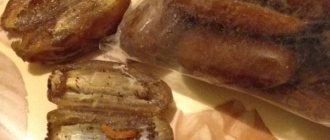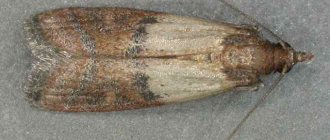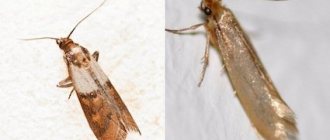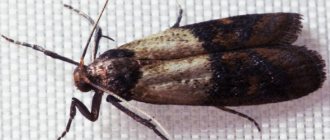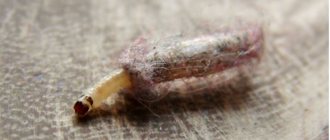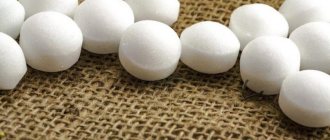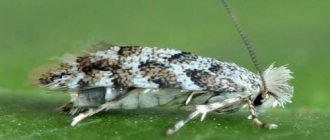What does a fruit moth look like (photo)
Fruit moth: photo of the pest.
How to get rid of worms in dried fruits - there are worms in the dryer, what should I do?
It is not difficult to detect insects in dried apples: at the bottom of the container in which they are stored, you can see white worms, light lumps, and the remains of cocoons of moth larvae. Moths are capable of multiplying everywhere: not only in dried fruits, so it will not be difficult to detect traces of its presence inside cabinets, on the walls of furniture or premises.
Moth in dried apples
How to get rid of fruit moths and protect dried fruits from them
Very often, dried fruits suffer from personal pests. Having sent dried apricots or figs for storage, after a while you may be surprised to find that they have become unusable. The fruit moth does not neglect other food: its larvae destroy banal dried apples brought from the village for compote and exotic tropical dried fruits with equal ease.
Description of the appearance of the pest
The very name of fruit moth is collective. Both grain and granary varieties are not averse to eating delicacies such as nuts or dried fruits.
If desired or necessary, they quickly switch their food priorities. However, in their many rows there is also a dried fruit moth, which is called more simply and briefly - fruit moth.
Similar species, differing little in description and way of life: fig and raisin moths.
If there is a tropical guest in the apartment, then it is quite easy to identify it. Fruit moths are characterized by the large size of adult individuals - 15-22 mm with a full wingspan. In this case, the front pair has a grayish-ocher color, with whitish spots and light “bands” in the form of transverse stripes. The hind pair is light gray, heavily pubescent with darker fringe.
The eggs are white, wrinkled, reach 0.5 mm in diameter, and have an oval shape. The larvae are large – 12-14 mm, and resemble worms. The pupae are no smaller in size, grayish with a longitudinal seam.
Lifestyle and reproduction
It is not difficult for fruit moths to get into an apartment: you can hardly notice its clutches in a package with the coveted dried fruits. In nature, it lives in the tropics, so it definitely won’t fly in through a window or ventilation. But in large warehouses, where the assortment is represented by nuts, apples, and dried fruits, this is a frequent guest.
True, given the huge number of related species, some other species that flew through a window or escaped from neighbors through the ventilation system could easily settle in a bag of dried apples or nuts.
Fruit moths are nocturnal, prefer high humidity - at least 60%, and for unhindered reproduction they need a temperature of 28-30 ° C, then at least 3 populations of insects are hatched per year.
One fruit moth butterfly can lay up to 350 eggs, from which white larvae hatch. Quite often they can be found in dried apricots or figs, but home-dried apples are also susceptible to this scourge.
Signs of appearance and damage caused
Usually, the appearance of fruit moths can be noticed when the products can no longer be saved: during the period of intensive growth of the larvae. They are the ones who leave behind dense lumps of excrement, pieces of cobwebs, and gnaw passages in dried fruits or nuts. And in general, it’s hard not to notice white worms scurrying around in a bag or package.
Features and description of the insect
Name: Fruit moth, subspecies of food moth Lat.:
Sitotroga cerealellaClass: Insects - Insecta Order: Homoptera - Homoptera Family: Electoptera - Gelechiidae.
| Habitats: | fruit trees, dried fruits in the house |
| Dangerous for: | dried fruits |
| Means of destruction: | heat treatment, traditional methods |
The development of fruit moths consists of several developmental phases:
The insect is a gray, inconspicuous moth . The body size does not exceed 3 cm with open wings. The period of butterfly activity is evening and dark, but during the day you can also see solitary individuals.
The eggs of the pest are very small, it is almost impossible to notice them. During her short life (up to 2 weeks), one female lays about 100 eggs under favorable conditions available in a house or apartment.
The larvae look like ordinary small white caterpillars with a dark muzzle. After the larva has accumulated enough energy by eating food, it wraps itself in a cocoon and a few days later a moth hatches.
Life cycle of a moth.
Harm caused
It doesn’t matter what type (barn moth, cereal moth, flour moth, nut moth, fruit moth) has settled in your kitchen, the harm is the same. In any case, you need to get rid of it as soon as you notice the first butterflies.
Food moths eat almost everything - the larvae are found in cereals, sugar, flour, bread, dried fruits, nuts, dried mushrooms, tea, pasta, seeds, and pet food.
In addition to eating, the larva weaves cocoons from silky threads reminiscent of a spider's web. They look like wool balls and pellets. She sheds her skin several times, changing her skin. Don't forget about defecation products and dead larvae.
All this makes food unsuitable for consumption unless you want to develop severe intoxication, a severe allergic reaction, problems with the immune system, or cause other harm to the body.
Adult butterflies, constantly flickering before your eyes, have the unpleasant property of getting into cups of drinks and pots when cooking.
The longer you wait, the harder it is to get them out later.
Pest detection
It is very easy to detect pests in dried fruits. At the bottom of the container in which dried fruits are located, you can most likely find small worms, strange light pellets or traces of cocoons.
However, food moths can breed in other places. It can often be found on walls or cabinets near the feeding area.
Many people often confuse ordinary clothing moths with food moths, although both parasites harm humans: some spoil clothes, others spoil food. There are several varieties of food pests. Most species of food moths have a characteristic light yellow pattern on the wings and are smaller in size.
Moth caterpillars in dried fruits.
Rule No. 6 – Avoid harmful neighborhoods
Dried apples absorb odors very quickly.
It is enough to stand them next to spices, onions or other products for one day so that the pleasant aroma of apples is distorted beyond recognition. All bright-smelling products are considered harmful for apple drying. Among them:
- citrus fruit;
- bananas;
- cabbage;
- potato;
- garlic and onion;
- herbs.
You should also remember that the main source of moths and bugs are cereals, flour and pasta. If the housewife is not sure of their purity, the products should be kept in quarantine for some time, separately from dried apples.
Note. This rule applies to drying materials stored in boxes and fabric bags.
For dried apples in boxes and bags, storage in cellars, garages and basements is generally not recommended. It is better to place supplies in the pantry among preserved food in jars or on a glassed-in loggia.
How to avoid insects
To protect dried fruits from numerous problems such as mold or insects, it is recommended to resort to disinfection and sealed packaging.
The main thing in this matter is to work for prevention, because preventing the pest from reaching your supplies is much easier than later removing it and throwing away the products.
Citrus peels are an excellent moth repellent.
Many insects, including fruit moths, cannot tolerate strong odors, which repel food. Placing bay leaves and lavender leaves nearby will help preserve dried fruits. Furniture can be wiped with fir oil or vinegar, all of which repel pests.
It would also be a good idea to place dried lemon, tangerine or other citrus peels in the same place. The main thing is to keep them separately, and not inside bags or jars of apples, so that the latter are not saturated with other people's aromas.
I also use my grandmother’s method to store it in fabric bags. It is not right?
I can’t say whether it’s right or wrong, but from the height of my experience I will say that I switched to plastic jars with multi-colored lids. And my soul is pleased that everything is in order and the dried fruits are in order.
Doesn't the common food moth eat dried fruits?
He eats, and how. They are tasty and healthy for her. In fact, fruit moths are one of the food varieties.
Rule No. 1 – Comply with storage conditions
The first thing the housewife should take into account is that only clean, well-dried apples are suitable for long-term storage. They cannot show signs of mold. It is important that the dried apple ring remains elastic and soft, but that no juice is released when squeezed. This drying will be stored well if you follow the storage conditions:
- dry, ventilated room;
- protection from direct sunlight;
- temperature +0+10 degrees;
- clean and dry storage containers;
- no contact with fresh vegetables, fruits, household chemicals.
Dried fruit protection
It is necessary to throw away those food supplies that were in the potential infection zone and those in which traces of vital activity were clearly found. Such products contain excrement and remains of the insect cocoon, which can cause complications if they enter the human body.
Proper storage is the best protection.
How to save dried fruits from moths
Clean storage is the key to quality.
Butterflies and food moth larvae love a warm and humid environment (approximately +25°C and 50% humidity). If your house is hot and damp, then removing the fires will become a very labor-intensive task. It is best to thoroughly ventilate all rooms before processing, dry corners, throw away damp cereals, bread, etc.
With any storage method: indoors at home, in the attic or on the balcony, often check the condition and quality of dried apples in order to prevent them from spoiling in time.
By following simple storage and prevention rules, you can keep your harvest intact.
How to store dried fruits
Improper storage of dried fruits is the most common mistake that contributes to the appearance of the parasite.
Before the season, the storage area must be wiped with a disinfectant and washed thoroughly so as not to leave dirt and foreign odors that attract pests.
To avoid spoilage of your favorite products, you need to follow simple rules:
- The use of paper or cellophane bags is undesirable, as the pest can easily gnaw through their walls. In addition, condensation collects in plastic bags, which contributes to the formation of mold.
- The best storage containers are glass jars with tight-fitting lids. After the fruit has been poured inside the jar, cover it on top with paper, which will absorb excess moisture.
- A shaded shelf or wall cabinet is best for storage. Such places should be well ventilated and ventilated, and the temperature should be about 10 degrees.
- Excess moisture in the closet or on the shelf will help to remove table salt poured into a plate and placed next to it.
- From time to time it is necessary to check dried fruits in the storage containers themselves. If they feel a little sticky to the touch, then you need to pour them out, dry them a little and place them back in a dry container, replacing the old paper.
What is the best way to store apples?
Apples, which have already absorbed so much sun rays, cannot tolerate light in their dried form - it is better to store them in a dark place.
It is very good if it is also ventilated - this will protect the product from mold and prevent it from getting stale.
You need to choose the packaging carefully: if it is loose, six-legged robbers will crawl through the cracks, and a completely “dead” container, such as a plastic bag or plastic container, will completely block the access of air.
Then the product will begin to “suffocate”, “sweat”, become covered with mold and also deteriorate. Waxed or wrapping paper placed at the bottom of a storage unit: a basket, cardboard box, glass jar or box is a good remedy against this scourge.
Another layer of paper, for better preservation, is placed on top of the apples. In a dark place where the dried crop will be stored, you can also put a bowl of salt - it will also help fight excess moisture.
We recommend reading
How to fertilize apple trees in the fall
How to store grapes at home
How to store pears at home
How to grow an orchid from seeds at home?
Fighting methods
There are a large number of ways to combat fruit moths.
Do not rush to use chemicals. We must remember that there is a large amount of food in the kitchen, and the contact of reagents on them can cause more harm than from an insect, especially for a product such as dichlorvos.
If, nevertheless, a decision was made to smoke out the pest with chemicals, then it is necessary to protect yourself as much as possible with personal protective equipment, remove all food supplies away, and after the end of the “war”, thoroughly wash all the places where the poison could get in.
So it is better to use simple, time-tested and many years of experience, methods of struggle that will not harm your health.
Heat treatment
Temperature treatment.
If the situation with dried fruits is not hopeless, that is, only adults and no traces of larvae were noticed, then you can try to save the dried apples using heat treatment.
The insect does not like high temperatures. First of all, you need to sort through all the apple slices, throw away any damaged ones, and place the untouched apples on a baking sheet in 1 layer. Then preheat the oven to 70 degrees and place a baking sheet in it for 20-30 minutes.
Traces of vital activity in drying.
The parasite larvae also cannot tolerate low temperatures, which are fatal to them. If it is not possible to warm up the infected fruit, then you can use an alternative method. In winter, you can put the fruits on the balcony; it is advisable that the temperature be from -10 degrees.
If the winter is warm, then you can put the apples on the shelf of the refrigerator or freezer, keeping them there for up to 24 hours. After any type of processing, dried fruits must be placed in dry containers that can be hermetically sealed.
Using improvised means
There are not always any chemical means to combat moths at home, and not everyone wants to use them in the kitchen where food is stored. In such cases, improvised means and folk methods will help in the fight against the pest:
- Prepare traps from flour and boric acid, which are mixed in proportions of 1 to 3, then poured into a small container and placed on the kitchen shelf.
- You can lubricate the walls of furniture where moths have infested with lavender oil.
- Experience shows that an effective means of control is the smell of tobacco, which repels parasites well.
- Orange peel, which after cleaning is laid out inside the furniture, has a good effect.
- Ammonia helps destroy eggs and at the same time disinfect the place where they live.
Read more about safe food protection, which will be a very pleasant preventive measure, here.
Video
We invite you to watch a video about a proven method of storing dried apples:
He has considerable experience in gardening - from sowing seeds and seedlings to harvesting and storing the crop. Each sowing season begins with the search for new ways of growing, because cucumbers can be collected not only from the garden, but also, for example, from... a barrel and even grown on a windowsill in winter. She considers caring for plants one of the best ways to relieve stress.
Found a mistake? Select the text with the mouse and click:
The homeland of pepper is America, but the main breeding work on developing sweet varieties was carried out, in particular, by Ferenc Horvath (Hungary) in the 20s. XX century in Europe, mainly in the Balkans. Pepper came to Russia from Bulgaria, which is why it received its usual name - “Bulgarian”.
Tomatoes have no natural protection against late blight. If late blight attacks, any tomatoes (and potatoes too) die, no matter what is said in the description of the varieties (“variety resistant to late blight” is just a marketing ploy).
In little Denmark, any piece of land is a very expensive pleasure. Therefore, local gardeners have adapted to growing fresh vegetables in buckets, large bags, and foam boxes filled with a special earthen mixture. Such agrotechnical methods make it possible to obtain a harvest even at home.
Natural toxins are found in many plants; Those grown in gardens and vegetable gardens are no exception. Thus, the seeds of apples, apricots, and peaches contain hydrocyanic acid, and the tops and peels of unripe nightshades (potatoes, eggplants, tomatoes) contain solanine. But do not be afraid: their number is too small.
You need to collect medicinal flowers and inflorescences at the very beginning of the flowering period, when the content of nutrients in them is highest. Flowers are supposed to be picked by hand, tearing off the rough stalks. Dry the collected flowers and herbs, scattered in a thin layer, in a cool room at natural temperature without access to direct sunlight.
Humus is rotted manure or bird droppings. It is prepared like this: the manure is piled up in a heap or pile, layered with sawdust, peat and garden soil. The pile is covered with film to stabilize temperature and humidity (this is necessary to increase the activity of microorganisms). The fertilizer “ripens” within 2-5 years, depending on external conditions and the composition of the feedstock. The output is a loose, homogeneous mass with a pleasant smell of fresh earth.
It is believed that some vegetables and fruits (cucumbers, stem celery, all varieties of cabbage, peppers, apples) have “negative calorie content,” that is, more calories are consumed during digestion than they contain. In fact, only 10-20% of the calories received from food are consumed in the digestive process.
A new product from American developers is the Tertill robot, which weeds weeds in the garden. The device was invented under the leadership of John Downes (creator of the robot vacuum cleaner) and works autonomously in all weather conditions, moving over uneven surfaces on wheels. At the same time, it cuts off all plants below 3 cm with the built-in trimmer.
Oklahoma farmer Carl Burns developed an unusual variety of multi-colored corn called Rainbow Corn. The grains on each cob are of different colors and shades: brown, pink, purple, blue, green, etc. This result was achieved through many years of selecting the most colored ordinary varieties and crossing them.
Prevention
Moths can enter human habitation in a variety of ways. Favorable conditions contribute to the fact that even several adult individuals can breed into entire colonies in the shortest possible time. There is no 100% way to protect your home from moths.
But if you carry out simple prevention and follow the advice, you can reduce this risk to a minimum:
- It is advisable to have a fine mesh on windows and hoods, through which pests will not be able to enter the room.
- You should buy products from trusted stores in order to exclude the possibility of introducing insects from outside. Also, before purchasing, you must visually check the packaging for leaks.
- It is better to store food supplies not in packages, but pour them into glass, tightly closed containers.
- From time to time it is necessary to wipe the shelves with water and vinegar or essential oils.
- The food storage area must be dry and ventilated.
- It is better to store nuts or dried fruits in glass containers that are hermetically sealed.
- And in general, it is better to keep the kitchen and dry fruit storage areas clean. This will prevent the appearance of not only moths, but also other insect pests.
Destruction of moths
Methods of killing moths
The moth is not distinguished by its quick reaction or strong flight abilities. It's easy to slam him. But there is no guarantee that this is the only or last butterfly in the room, so you should play it safe and use effective moth repellents in the apartment and in the kitchen in particular.
- Sticky tapes are hung around the kitchen, anti-moth tablets and special traps are used in cabinets.
- Among the folk remedies, herbs such as lavender, peppermint, chamomile, and geranium will help repel the pest. These plants repel moths with their scent. Orange peels and garlic are also excellent repellents.
- Ventilating the kitchen for 20 minutes every evening during cold periods reduces the activity of moths and creates unfavorable living conditions for them.
- In case of severe infestation of the premises, aerosols and moth sprays are used. Initially, they carry out cleaning to destroy the larvae, wipe down the cabinets, and hide the food in airtight containers. Disinsection is carried out. Use any insecticidal agent - Raptor, Raid, Antimol, Clean House, Dichlorvos. After 20 minutes, ventilate, carry out wet cleaning by adding baking soda and laundry soap to the water. An alkaline environment completely neutralizes the effect of the insecticide.
External characteristics
If you have observed repeated appearances of butterflies over the course of three weeks, this is evidence that the infestation is quite serious and it is necessary to immediately take steps to eliminate the insects.
The winged moth is no longer capable of causing any harm, since their oral organ is reduced upon reaching sexual maturity. Parasites are their larvae, which, having powerful jaws, feed quite intensively and accumulate energy reserves so that upon reaching the adult stage they have the opportunity to reproduce.
Interesting fact! The absence of a proboscis is due to the fact that, upon reaching sexual maturity, the moth loses not only the ability to feed, but also to digest food. Therefore, they simply do not need this organ.
The caterpillar's head is brown. As a rule, infestation of dried fruits and vegetables with this type of moth will be indicated by small, neat nests and a thin cobweb around them. The larva will be inside the nest.
Which varieties are best for drying?
For drying, it is advisable to select fruits that have a small seed pod and thin skin . Prepared sorted fruits are washed and cut into pieces or circles.
The best apple varieties for storage are those that have dense white flesh and are sour or sweet and sour.
These include:
- Titovka;
- Aport;
- Pippin;
- Antonovka;
- Grushovka and others.
It is recommended to send apples for drying immediately after cutting. This way all the beneficial qualities of the fruit will be preserved in the best possible way.
Damaged and rotten areas should be cut off . If drying is carried out in the open air, the laid out pieces of apples are covered with gauze on top, protecting them from flies and beetles.
You can dry almost any apples after removing the damaged areas. But from sweet varieties the yield of dry product will be much less, and the taste after drying will be less pronounced.
